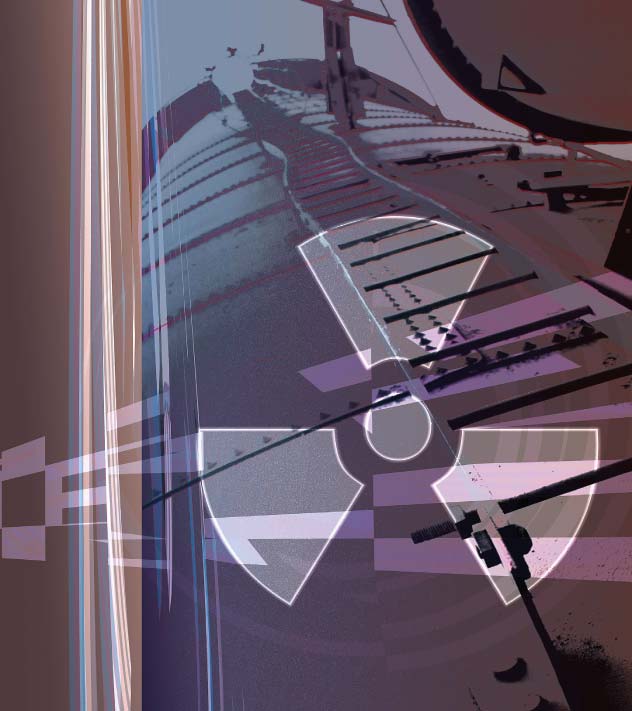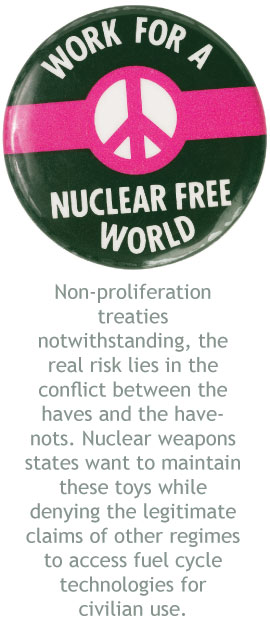COVER STORY:
Nuclear Energy: An Awful Option
The solution to accelerating global warming and power shortages does not lie in a vast expansion of nuclear power plants connected to nationwide electrical grids, argues veteran neutron scientist Radhakrishna.

The legendary clock of the Bulletin of Atomic Scientists marking the time left for an estimated nuclear catastrophe has sensitized generations of neutron scientists and others to the possibilities of nuclear accidents.
Current public interest in nuclear power, encouraged and promoted by political and economic interests, has led to a revival of the debate — Does the solution to accelerating global warming and power shortages lie in a vast expansion of nuclear power plants connected to nationwide electrical grids?
Most scientists have now identified the major risks for survival — climate change, depletion of resources and a shortage of energy. Some of them profess an article of faith that such problems can be solved by more effort and technology.
It is indeed likely, to some extent, that the large-scale expansion of nuclear power will help to mitigate the consequences of these phenomena. However, this technology is fraught with such uncertainties and unpredictable, potentially catastrophic consequences, that a choice is very difficult.
It is the purpose of this article to argue that nuclear power is not the answer.
 The three classical risks associated with the nuclear option are: the link between the nuclear fuel cycle and the proliferation of nuclear weapons, the possibility of nuclear accidents and the problems of the disposal of the nuclear waste. The three classical risks associated with the nuclear option are: the link between the nuclear fuel cycle and the proliferation of nuclear weapons, the possibility of nuclear accidents and the problems of the disposal of the nuclear waste.
Recent political developments have shown that proliferation is a genuine danger. Israel, North Korea and Pakistan have been able to acquire these weapons. It is difficult to count on the sagacity or common sense of political leaders. Dr Strangelove is an imaginary character, but Dr. Henry Kissinger is not. Political psychopaths proliferate in many countries. A revered leader in China stated that in a nuclear war they could absorb a loss of two hundred million and then “recover.” General Mirza Aslam Beg, former chief of the Pakistan Army, is on record: “ We can make a first strike, and a second, and even a third” on India and the prospect left him unmoved: “One has to die anyway....”
The current arms race in North-East Asia and in the Middle-East, mostly based on massive sales of non-nuclear weaponry, tempts a weak power to use nuclear weapons when hemmed in by threats of destructive bombing, a favorite option of the sole superpower. Recently a B-52 bomber flew 1,400 miles from North Dakota to Louisiana carrying six nuclear-tipped cruise missiles and could have, with a different choice of route, triggered a major catastrophe.
The extremely low probability of nuclear accidents in industrial power plants, ensured by extreme attention to detail, is however, offset by their potentially catastrophic consequences, and it is not clear that it will be possible to install an international regime strict enough to remove all risk of such incidents.
Finally, we do not know enough about the risks in storing and disposing of a nuclear waste product with an activity increasing with age and peaking around an estimated thousands or tens of thousands years in the future. If all these factors, and the expense, are taken into account, it is indeed a very risky technology. In general, the public is aware of these issues, but they are technical and difficult to grasp.
These risks and uncertainties have led to considerable hesitation among industrial investors. They are asking for heavy loan guarantees, regulatory insurance and faster licensing procedures. These complex plants take a very long time to build. It has been 25 years since a completed power plant has been delivered in the U.S. and the infrastructure is no longer there or is obsolete. It has to be imported or rebuilt, and that is a limiting factor.
The special feature of this technology arises from the mix of three factors — economic, technical and political, to a greater extent than in other applications.
A great expansion of the fuel cycle is essential to fill the energy requirements, and that makes nuclear weapons so much more available. The number of reprocessing plants required is difficult to estimate. The problem of dealing with the spent fuel has its own economic, technical and political facets. The notion of depositing it in deep mines has been tossed around since 1957, and it has not been satisfactorily implemented. The cost of a proposed site at Yucca Mountains has risen continuously.
Our knowledge of the geological migration of these disturbed zones in the future is incomplete. It is calculated that peak radiation doses will occur thousands of years in the future, and predictions of human population distributions, and that of the migrating radionuclides introduce great uncertainties. Dumping radioactive waste in less developed countries will be a temptation, which would make economic sense.
The production of 1 kg of nuclear fuel enriched to 5 percent in U-235 requires 11.8 kg of natural uranium and 10.8 kg of depleted uranium containing mostly U-238, are left behind. In the U.S. about 0.5 million metric tons are stored. It has three uses — to produce plutonium in reactors, as dense armor-penetrating shells when alloyed, and in Boeings as ballast. The U.S. used 320 tons of this toxic material in the Gulf War. It produces plutonium when in fast neutron breeder reactors, but the major attempt of this kind, Superphenix, at Creys-Malville, in France, has been shut down, for various reasons.
Finally the risk of nuclear accidents has new features. The probability can perhaps be deemed fairly low, but the extremely serious consequences may make them unacceptable. There are three factors which determine the scenario: (a) Design defects which involve guessing modes of failure; (b) Maintenance of ageing parts with unpredictable behavior; and (c) The unpredictability of human behavior under stress. The mistakes of the human actors at Three Mile Island in the U.S. and at Chernobyl in erstwhile Soviet Union strongly influenced the way the consequences evolved. In the wake of a poorly-designed experiment in the reactor at Pripyat, Ukraine, on April 27, 1986, the chemical explosion blew off the covers, releasing more than 50 tons of radioactivity carried 800 miles to Sweden the next day, raising the radioactivity to more than 40 percent above the normal. The author recalls the rise in radioactivity in Saclay, which forced a curtailment of his measurements in progress. The French immediately suspected the German reactor at Fessenheim.
As scientists, we generally have a well-founded faith that we can solve most problems created by us with a suitable application of effort and appropriate technological methods.
However, if an objective look at a situation shows that one cannot reach such a conclusion, that the risks are simply unknown and can lead to grave outcomes, it is useful to ask if it is necessary to take the risk involved. We have to balance the possible catastrophic consequences of climate change against the risks of lethal contamination. A world without humans is not a fantasy.
The issue of nuclear weapons is the strongest argument against nuclear power. Non-proliferation treaties notwithstanding, the real risk lies in the conflict between the haves and the have-nots. Nuclear weapons states want to maintain these toys while denying the legitimate claims of other regimes to access fuel cycle technologies for civilian use.
They have the obligation to achieve nuclear disarmament under treaty, and if they do so seriously, the international climate could change in favor of an effective and joint effort to tackle global warming and similar problems. Otherwise, it just will not happen.
So what are the alternatives?
The biggest impact on carbon emissions is likely to be secured by simply increasing the efficiency of energy utilization in houses, commercial establishments and in industries. The production of electricity, energy costs for transportation and heating are clear targets.
Instead of focusing on the production of more energy, more attention devoted to efficiency might reduce the urgency of this agonizing choice. Massive savings in energy consumption are possible in housing, domestic consumption, in commercial and industrial enterprises well as in heating, and transportation. Smaller fuel-efficient cars for the short commuting trips of urban life are more efficient, and the technology is already available.
Decentralized increases of the supply of energy from solar and wind farms, geothermal units, some types of biomass, combined with some natural gas and fossil fuels as backup would avoid these stark choices.
However, it is probably unrealistic to hope for a cooperative, compassionate political effort from predatory developed countries and their emulators which will address these options for the less favored. That is another story. . . |